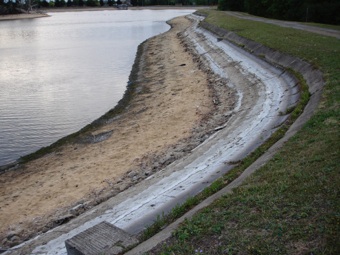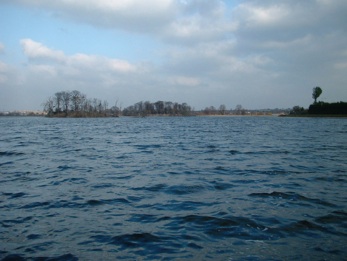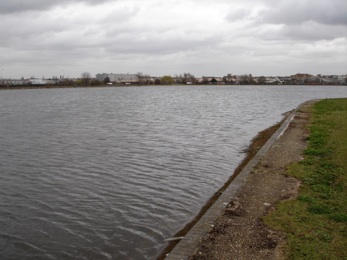Basic Advice

Despite many people apparently having little difficulty in extracting regular limits, these reservoirs can still outwit the newcomer.

Let’s get one disadvantage out the way first. With no extensive shallows, these reservoirs can take a long time to warm up in the Spring. If you want floating line sport in March and early April, you’re better off looking to smaller fisheries, or reservoirs with shallow areas which are quick to warm up, like Bewl. To do well at Walthamstow this time of year, you’ll have be prepared to fish deep with Boobies, and be aware that the best time might only be a couple of hours around mid-day to mid-afternoon, when fish might move in close up the slope.
The advantage of such depths is that Walthamstow carries on fishing well into the first frosts in January-February. With Thames Water stocking more consistently into November in recent years, these reservoirs are a more reliable prospect at a time when smaller and shallower fisheries are getting too cold and slowing down.
Like all fisheries, Walthamstow has its dog-days in the height of summer. But consider this. Unlike shallow shelving reservoirs, here the bank angler has some chance of reaching deep-lying fish, either with a floater/midge-tip and a heavily leaded point fly, or a DI5, DI7 40+ or shooting head type line and Booby. The model we recommend is the 40+ Expert with the grey running line. It saves you having to make up your own shooting head and the running line is more tangle-free than most types of monofilament backing.
Another advantage is that there are no boats on Walthamstow. When fish do retreat to the depths, they don’t have their numbers steadily reduced by boat anglers. When conditions improve those fish are still available in the same numbers for the bank angler.
While the club’s Autumn League proves the strength of this back-end fishing, our Wednesday Evening Series has shown that it it still possible to extract fish under apparently adverse conditions, and that such conditions can change very quickly.
At the height of the 2004 heat-wave, two Wednesdays of fishing deep with Boobies were followed by an evening of catching on fry patterns just under the surface. Seven days of wet, windy weather had quickly made the top layers the most attractive place for trout.
Another lesson this series has taught us is not to assume that the method or the location you start on is the one that’ll do the business.

Fish across the wind when conditions are ideal and fish are moving upwind to feed in April-May-June. And fish with your back to the wind at the height of summer in June-July-August where the cooler water will be.
At some stage fry will come into the equation, with fish often seen crashing after them, even when fishing is apparently difficult. You’re better off doing a circuit of the reservoirs to look for moving fish before you start fishing, but but be aware that conditions which suit masses of fry hanging around the edges don’t always last. The 2007 Wednesday Evening Series saw big fry-feeders coming out one week in mid-June. By the next week conditions had changed and those fry had moved out.
Methods. One particularly hard evening a few years ago saw a winning bag taken only after 10 different methods had been tried. These included Buzzers, Crunchers, Pinfry and Minkies on the floater, Boobies on the DI7, with the successful tactics being Minkies on the Clear Intermediate and the roly-poly. 2007 saw a colder summer with long periods of superb fishing to dries. This is not typical, and often we have to be a lot more versatile.
Even with Boobies on the DI7 or DI5 it has become clear there is a big difference between fishing them along or near the bottom, and exploring the mid-water options. Classic Fur & Feather tactics used to be a single large-eyed Booby, 9-12ft leader, retrieved with a moderately fast roly-poly or figure-eight.

For the milder conditions we’ve experienced in the last couple of Decembers, this has only been effective for the first hour or so, after which you’re better off adding another Booby and lengthening your leader to 18-21ft with a dropper 9ft from the point, to be fished with a slow figure-eight. Even then, 2007 saw some people change to a single Booby on a DI3 to follow fish which had moved up even higher.
One problem with medium sinking lines at Walthamstow is the band of weed that grows just beyond the end of the concrete sill about 2 rod-lengths out. Unless you pick your fly out early (and miss out on last-second takes from a following fish) anything faster than an intermediate fished quite shallow, will drag your fly through this grot every time. A floating line and a leaded fly is better, with a couple of droppers too if you can handle them, and more recently we’ve found the new range of midge-tip lines with 3-10ft tips useful for this, as well as helping to get a team of flies down, especially on the steeper banks of Nos 4 and 5 reservoirs in a side wind.
Intermediate lines can be especially useful for fishing big flies like Minkies in an awkward wind. On floater you may need a longish leader to get them down to the right depth, a set-up which is not easy to cast into or across a stiffish breeze. Additionally, a side-drift can push the floating line round, preventing you from getting the fly down. It’s a lot easier to cast and get depth with a shorter leader on an Intermediate. In really awkward conditions a Minkie or Booby on a short 9ft leader and a double taper Intermediate can catch you fish no-one else can reach.
Fly patterns are another way Walthamstow is different. Other fisheries see trout stuffed with midge pupae. Here, they gorge on daphnia with just the occasional midge, at all times of the year. Most of the daphnia they feed on is a greeny olive colour with a touch of orange. It’s no surprise that one of our favourite leaded nymphs is precisely this colour, with a body made from a blend of 75% Green Olive and 25% Hot Orange seal’s fur. When people tell you they caught their fish on a ‘Damsel’ don’t think they were fishing an imitation of a damsel nymph. It’s just a big leaded nymph of the same colour as the food our trout most prefer.
